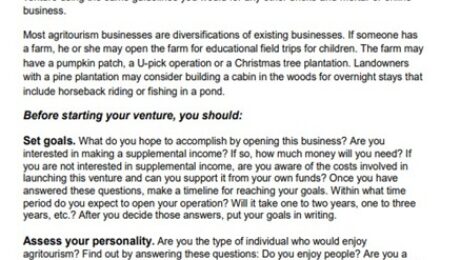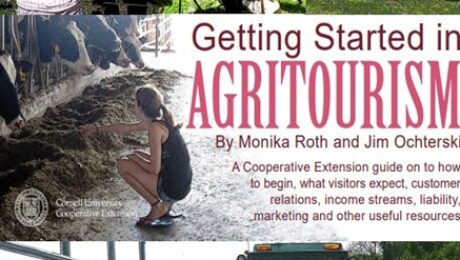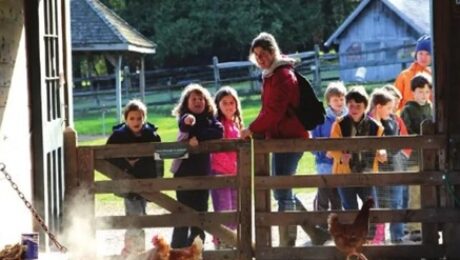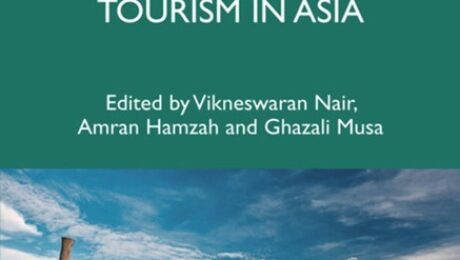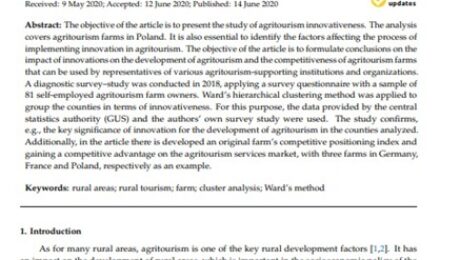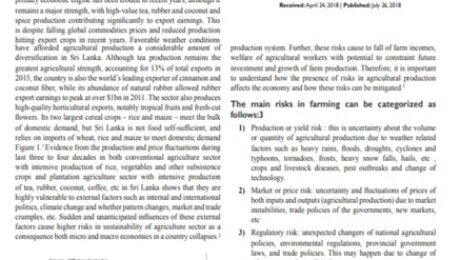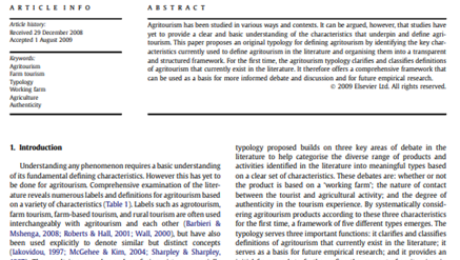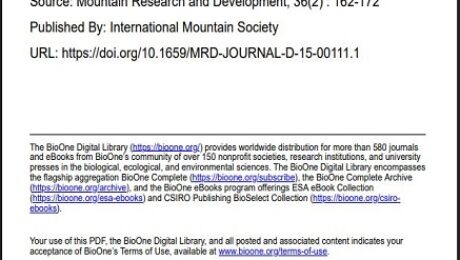12 Things to Consider When Starting an Agritourism Business
Agritourism is a business venture on a working farm, ranch or agricultural enterprise that blends entertainment, education and tourism to provide a fun, exciting and memorable experience for people of all ages. Because it is a business, structure the venture using the same guidelines you would for any other bricks-and-mortar or online business.
Most agritourism businesses are diversifications of existing businesses. If someone has a farm, he or she may open the farm for educational field trips for children. The farm may have a pumpkin patch, a U-pick operation or a Christmas tree plantation. Landowners with a pine plantation may consider building a cabin in the woods for overnight stays that include horseback riding or fishing in a pond.
- Published in AGROTOURISM
Getting Started in Agritourism
There is a great deal of interest in agritourism as a niche tourism sector for farms. People are looking for an authentic farm experience that might link them to their past or that teaches them something new. Visitors also want relief from the stress of everyday life to experience a seemingly simpler life. Farm visits offer a day in the country, where guests may pick berries, go for a hayride, sample
homegrown or homemade products, see animals, and learn how farms operate.
READ MORE
- Published in AGROTOURISM
A Guide to Successful Agritourism Enterprises
Agritourism activities are becoming an important component of many farm operations. These activities have the potential to increase farm revenues and maintain the sustainability of the industry. However, agritourism activities won’t suit every farm or farmer. Before starting an agritourism operation, it is recommended that farmers spend some time assessing the potential that these activities have for their operation, and carefully planning the business and marketing elements of their operation. This guide will help with all the planning that goes into running successful agritourism operations.
- Published in AGROTOURISM
Responsible Rural Tourism in Asia
The rural tourism sector has become a key driver for social and economic growth and a major source of income for developing and low-income countries in many parts of Asia. Rural tourism is progressively viewed as a solution, increasing the economic viability of marginalised areas, stimulating social regeneration and improving the living conditions of rural communities. Responsible rural tourism promotes conservation of the natural environment, protects the authenticity of culture, and offers socioeconomic opportunities and benefits for local communities. This book encompasses case studies from a range of Asian countries and examines both successful and failed attempts in developing responsible rural tourism, and the learnings that we can adopt and adapt for future responsible rural tourism in the region. It will be of interest to students, researchers, stakeholders and policymakers in tourism.
- Published in AGROTOURISM
Innovations in Agritourism: Evidence from a Region in Poland
The objective of the article is to present the study of agritourism innovativeness. The analysis covers agritourism farms in Poland. It is also essential to identify the factors affecting the process of implementing innovation in agritourism. The objective of the article is to formulate conclusions on the impact of innovations on the development of agritourism and the competitiveness of agritourism farms that can be used by representatives of various agritourism-supporting institutions and organizations. A diagnostic survey–study was conducted in 2018, applying a survey questionnaire with a sample of 81 self-employed agritourism farm owners. Ward’s hierarchical clustering method was applied to group the counties in terms of innovativeness. For this purpose, the data provided by the central statistics authority (GUS) and the authors’ own survey study were used. The study confirms, e.g., the key significance of innovation for the development of agritourism in the counties analyzed. Additionally, in the article there is developed an original farm’s competitive positioning index and gaining a competitive advantage on the agritourism services market, with three farms in Germany, France and Poland, respectively as an example.
- Published in AGROTOURISM
Promotion of agro tourism in rural areas of Galle district in Sri Lanka
The sector remains an economic mainstay and primary national employer. As manufacturing and industrial activities have expanded, agriculture’s position as the primary economic engine has been eroded in recent years, although it remains a major strength, with high-value tea, rubber and coconut and spice production contributing significantly to export earnings. This is despite falling global commodities prices and reduced production hitting export crops in recent years. Favorable weather conditions have afforded agricultural production a considerable amount of diversification in Sri Lanka. Although tea production remains the greatest agricultural strength, accounting for 13% of total exports in 2015, the country is also the world’s leading exporter of cinnamon and coconut fiber, while its abundance of natural rubber allowed rubber export earnings to peak at over $1bn in 2011. The sector also produces high-quality horticultural exports, notably tropical fruits and fresh-cut flowers. Its two largest cereal crops – rice and maize – meet the bulk of domestic demand, but Sri Lanka is not food self-sufficient, and relies on imports of wheat, rice and maize to meet domestic demand Figure 1.1 Evidence from the production and price fluctuations during last three to four decades in both conventional agriculture sector with intensive production of rice, vegetables and other subsistence crops and plantation agriculture sector with intensive production of tea, rubber, coconut, coffee, etc in Sri Lanka shows that they are highly vulnerable to external factors such as internal and international politics, climate change and whether pattern changes, market and trade crumples, etc.
- Published in AGROTOURISM
A typology for defining agritourism
Tourism and the Sustainable Development Goals – Journey to 2030 serves as a guide to how the tourism sector can contribute towards the implementation and achievement of the 17 SDGs. It aims to inspire governments, policymakers and tourism companies to incorporate relevant aspects of the SDGs into policy and financing frameworks as well as business operations and investments. The publication’s recommendations are based on an analysis of 64 countries’ Voluntary National Reviews (VNRs) on the SDGs – submitted to the United Nations High-level Political Forum on Sustainable Development in 2016 and 2017 – as well as eight Mainstreaming, Acceleration and Policy Support (MAPS) country roadmaps and the CSR activities of 60 global tourism companies.
- Published in AGROTOURISM
Tourism and the Sustainable Development Goals –Journey to 2030
Tourism and the Sustainable Development Goals – Journey to 2030 serves as a guide to how the tourism sector can contribute towards the implementation and achievement of the 17 SDGs. It aims to inspire governments, policymakers and tourism companies to incorporate relevant aspects of the SDGs into policy and financing frameworks as well as business operations and investments. The publication’s recommendations are based on an analysis of 64 countries’ Voluntary National Reviews (VNRs) on the SDGs – submitted to the United Nations High-level Political Forum on Sustainable Development in 2016 and 2017 – as well as eight Mainstreaming, Acceleration and Policy Support (MAPS) country roadmaps and the CSR activities of 60 global tourism companies.
- Published in AGROTOURISM
LAOS-Study visit to an agro-tourism farm
The organic vegetable group in Houyoun village, Xay district, Oudomxay province is a member of the Lao Farmer Network (LFN) since 2016. The group has about 300 members in the village producing organic vegetables since 2015, which they sell to local market in Xay town. Besides growing vegetable, they also produce some grapes.
During the visit of the LFN secretariat in January 2017, the group expressed their interest to learn about processing wine and adding value to their organic vegetable garden. The idea of setting up agro-tourism also came out. However, they don’t have a clear ideas on how to do it or what are steps toward.
Because of these reasons, LFN organized a study visit for 10 Khmou farmers (5 women, 5 youth) from the Houyoun organic vegetable group to visit an agro-tourism site, the Vangvieng organic farm in Vientiane province, on 14-15 February 2017.
- Published in AGROTOURISM
Does Agrotourism Benefit Mountain Farmers? A Case Study in Phu Ruea District, Northeast Thailand
Agrotourism is widely advocated as a useful strategy to develop mountain agriculture and improve farmers’ income and quality of life. However, the relationship between agriculture and tourism is complex, and the extent to which tourism benefits farmers remains uncertain. This paper examines the relationship between agriculture and tourism and assesses to what extent agrotourism benefits farmers in Phu Ruea district, a popular tourist destination in the mountains of northeast Thailand. The Phu Ruea agrotourism system generated gross income for the district of almost US$ 16 million in 2014. About 80% of this income came from sales from specialty-crop farms and of tourism services operated by the households of local farms. The agrotourism system also created many employment opportunities for local people. There were 1500 people directly involved in the system, 90% of whom were farmers or members of farm households. Thus, there is no doubt that many local farmers derive significant benefits from their involvement in the agrotourism system. Although the Phu Ruea agrotourism system can be seen as a successful strategy for developing mountain agriculture, agrotourism is not a magic strategy to solve all the problems of rural development in the mountains. Only some localities are attractive to tourists, and only some farmers have the knowledge, skills, and resources to take advantage of the opportunities offered by tourism.
- Published in AGROTOURISM
- 1
- 2

